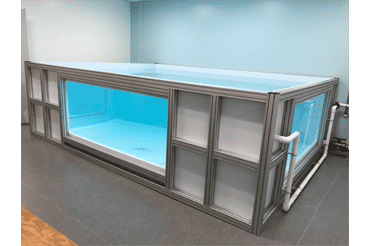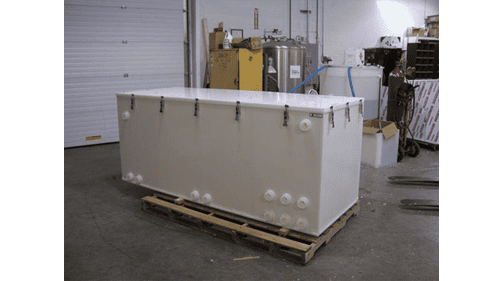The Complete Guide to Tank Fabrication
 Tank fabrication is the production process from designing large industrial tanks through assembling the tanks and their associated hardware or accessories. Tank fabrication can incorporate an extensive variety of design software, specifications, materials, production methods, and testing procedures, and each manufacturer specializes in distinct methodologies. For example, some manufacturers focus on traditional carbon or stainless steel tanks. Others specialize in plastic tank production because of the material’s nascent capabilities in different industries. At Plastic Design, Inc., we specialize in custom plastic tank fabrication.
Tank fabrication is the production process from designing large industrial tanks through assembling the tanks and their associated hardware or accessories. Tank fabrication can incorporate an extensive variety of design software, specifications, materials, production methods, and testing procedures, and each manufacturer specializes in distinct methodologies. For example, some manufacturers focus on traditional carbon or stainless steel tanks. Others specialize in plastic tank production because of the material’s nascent capabilities in different industries. At Plastic Design, Inc., we specialize in custom plastic tank fabrication.
Plastic Welding
Because plastic materials are easy to work with, manufacturers can produce plastic tanks through a range of different methods. One of the most common is plastic welding. Much like traditional welding, this process uses heat to create a molecular bond between two compatible thermoplastics. Plastic welding has three stages—pressing, heating, and cooling.
Manufacturers use a welding tool to create lines or spots of heated, melting plastic and then overlay another plastic sheet on top of the melted points. When the plastic cools and rehardens, it creates a strong, durable bond that can be used in products across a range of industries, such as dairy, food packaging, papermaking, and chemical. There are several different methods of this process, including ultrasonic, laser, vibration, spin, hot plate, and infrared welding.
Plastic welding reduces cycle times and provides superior strength. The finished plastic welds are lightweight and offer an airtight seal to prevent any leaks. Manufacturers commonly use it to conjoin plastic sheets when an adhesive binding is insufficient or unadvisable.
Other popular methods for tank fabrication include compounding (or blending), plastic lamination, molding processes, plastic extrusion, and plastic foaming.
Plastic Tank Applications
Plastic tanks are resistant to chemical and water damage. They can also handle heavy loads without forming stress cracks or being vulnerable to physical damage. These characteristics make plastic tanks ideal for sensitive industrial applications, such as in the biomedical, pharmaceutical, and semiconductor industries.
Biomedical and Pharmaceutical
These industries use a wide variety of chemicals to conduct tests and produce complex compounds and goods. Many of the base materials need to be stored for long periods of time in concentrated doses. Plastic tanks can handle alkaline and acidic chemicals and chemical compounds without degrading. The material is chemically inert, so manufacturers can worry less about the risk of degradation or contaminants from the tank material mixing into the chemicals. Plastic Design, Inc. produces plastic tank systems that range from single-use to USP Class 6 certification, so biomedical and pharmaceutical companies can safely use the tanks while remaining compliant with good manufacturing practices.
Semiconductor Manufacturing
Semiconductor manufacturing processes involve a lot of heat, caustic chemicals, and pressurized materials. Plastic tanks can withstand high temperatures and pressures without breaking down. The smooth and chemically inert surfaces of the tanks also ensure that the chemicals won’t break down the tanks or leech molecules from the tank and into the base material. Our chemical storage tanks and acid drums are safe, easy to clean, and reliable. Manufacturers can use them anywhere from general chemical storage sites to cleanrooms.
Materials Used in Plastic Tank Fabrication
At Plastic Design, Inc., we use three primary plastic polymers to create our tanks. These three materials are PVC, PVDF, and Polypropylene.
PVC
Polyvinyl chloride, or PVC, comes in different flexibility and rigidity levels based on the amount of plasticizers added to the compound. The material offers a low degree of flammability, resistance to corrosion, and resistance to chemical damage. However, the tensile strength of the plastic can vary depending on the level of plasticization.
PVDF
PVDF is a fluorocarbon with piezo-electric properties that operates best at lower temperatures that remain below 150°C. The material resists damage from abrasion, radiation, and chemicals. It’s also strong and easy to work with through melting processes. However, the material can’t incorporate glass fibers, is vulnerable to damage from fuming acids, and has a high dissipation factor.
Polypropylene
This polymer also works best at lower temperatures, though its range is greater than many other plastics because of its heat deflection properties. It has a high degree of tensile strength, and its semi-crystalline structure helps make it very resistant to chemical damage. However, it has elongation at break and a lower notched strength than other plastics. When it’s overheated, the material can become brittle.
Types of Tanks Provided
We design, fabricate, and finish many different types of tanks to suit different industries’ manufacturing processes, such as:
- Custom Plastic Tanks
 : We can produce tanks with different dimensions, including size, shape, and wall thickness.
: We can produce tanks with different dimensions, including size, shape, and wall thickness. - Custom Holding Tanks: Just like our custom plastic tanks, these can have virtually any specifications. Our design process also takes into account the weight stress of long-term chemical storage and weight distribution solutions.
- Custom Fabricated Day Tanks: We outfit all of our biomedical and pharmaceutical tanks with the tools for long-term chemical storage. Each tank features heavy walls and high load extrusion welding to reduce the risk of failure or contamination.
- Batch Mixing Tanks: These tanks can be customized to include auto-fill systems, closed-loop filtration, angled vanes for better mixing, and more. We can also build them to meet almost any design specifications. Our batch mixing tanks can handle shear mixing processes without including excess air.
- Double Containment Tanks: If your facility handles hazardous materials that are under pressure, our double containment tanks can help. They meet strict containment standards and failsafe mechanisms to keep the contents sealed away from the environment and nearby workers. The accessories for these tanks, such as plumbing, also meet strict standards, and the tanks can be outfitted with online leak detection systems.
- Custom Plating Tanks: These tanks enable recirculation and filtration. Our tanks include temperature controls and DC power supplies.
- Custom Closed Loop Filtration: These tank systems are built to handle your facility’s preferred pumping methods, such as high-volume centrifugal and positive displacement systems.
- Custom Fabricated Temperature Controlled Process Tanks: These tanks can handle wide temperature ranges, and we can fabricate either plastic or stainless steel varieties to handle both low and high-temperature operations or environments.
Choose Fabricated Tanks From Plastic Design, Inc.
At Plastic Design, Inc., we work hard to design and produce custom tanks that meet the needs of each of our customers. We’re an ISO 9001:2015 certified company. Our other certifications include Factory Mutual, Semi, NFPA, and OSHA. Learn more about our plastic tank design capabilities to see if we’re an excellent fit for your next project. You can also request a quote or specify your tank design requirements to get started.





